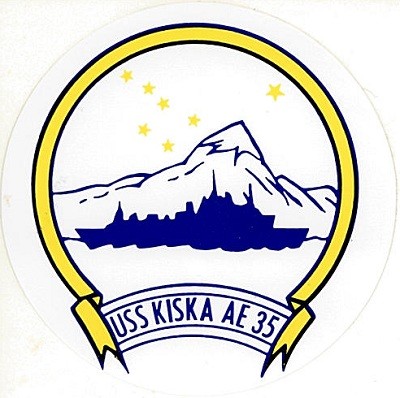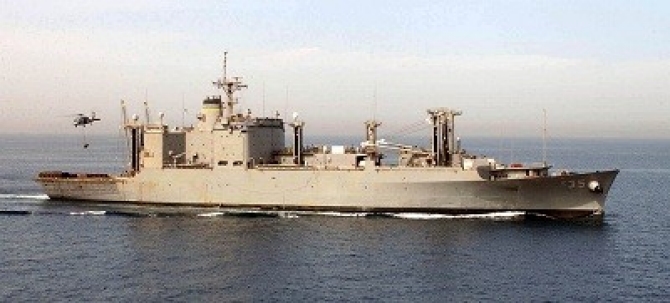Kiska (AE-35)
1972-2011
A volcanic island located in the Aleutian Islands chain of Alaska.
(AE-35: displacement 18,112; length 564'; beam 81'; draft 27'; speed 20 knots; complement 395; armament 8 3-inch, up to 12 .50 caliber or 7.62 millimeter machine guns, and two Boeing Vertol UH-46 Sea Knights; class Kilauea)
Kiska (AE-35) was laid down on 8 April 1971 at Pascagoula, Ms., by Ingalls Shipbuilding Division, Litton Systems, Inc.; launched on 11 March 1972; sponsored by Mrs. M. Angelique Kidd, wife of Adm. Isaac C. Kidd, Jr.; and commissioned at Charleston Naval Shipyard, S.C., on 16 December 1972, Capt. Jerred R. Rockwood, in command.

The blue sky and gold stars are adopted from the Alaska state flag and consist of a solid blue background with the seven stars of the big dipper. This represents the state of Alaska’s northernmost position relative to the other states. The North Star has served mariners for centuries as a guiding light for safe navigation. The mountain is representative of Mount Kiska, a volcano that rises from the island of Kiska that had been occupied without opposition by the Japanese on 7 June 1942 (as part of Operation AL), but evacuated before American and Canadian troops landed on the island on 15 August 1943. The silhouette portrays Kiska at sea, signifying her readiness to carry out her assigned mission anywhere in the world, during peace or war.
A Khmer Rouge gunboat illegally seized U.S.-flagged container ship Mayaguez in international waters on 12 May 1975. The communists held Master Charles T. Miller and his 39 sailors captive near the island of Koh Tang. Kiska sailed from Subic Bay, Philippines, to the Gulf of Thailand and supported the ships involved in the fighting (14–22 May). On 15 May, aircraft carrier Coral Sea (CV-43) and USAF aircraft operating from Thailand launched protective air strikes against Cambodian naval and air installations on the mainland. Air Force helicopters carried 288 Marines of Battalion Landing Teams 2 and 9 from U’Tapao, Thailand. The Marines assaulted Cambodian troops on Koh Tang, and 60 Marines and Sailors from escort Harold E. Holt (DE-1074) boarded the deserted merchantman. The Americans freed Mayaguez but the Khmer Rouge had already released their hostages. The battle cost the lives of 18 Marines and Sailors, while 50 more sustained wounds, along with the loss of three helos and damage to two. Attack aircraft carrier Hancock (CVA-19) received orders to support the rescue by operating as a helicopter platform with amphibious assault ship Okinawa (LPH-3), but neither ship participated. Kiska then visited Sattahip, Thailand (22–27 May).
In the wake of the Iraqi invasion of Kuwait on 2 August 1990, a coalition that eventually comprised 29 nations initiated Operation Desert Shield, a UN-sanctioned economic blockade of Iraq. After Saddam Hussein, the Iraqi leader, refused to withdraw his country’s troops, the coalition launched Operation Desert Storm to liberate Kuwait. Kiska deployed for those operations during the Persian Gulf War (I) (14 August 1990–15 May 1991).
Kiska was decommissioned and placed in service with the Military Sealift Command at the Fleet and Industrial Supply Center Oakland, Calif., on 1 August 1996.

Kiska was placed out of service at Pearl Harbor, Hi., on 13 January 2011, and on 30 May 2013, her Navy title was transferred to the Maritime Administration.
Detailed history under construction.
Mark L. Evans
3 February 2014


